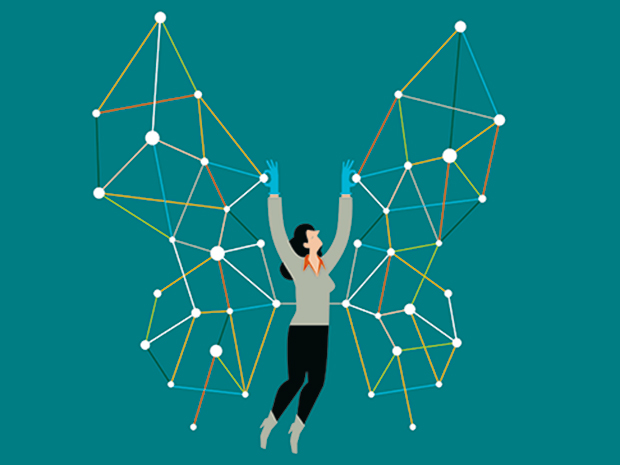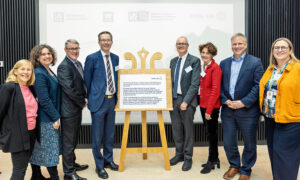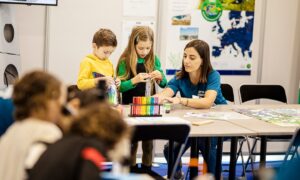
Forty things that make EMBL – Part 1
What comes to mind when you think of EMBL? As the Lab turns 40, and with the help of staff and alumni, here is an unofficial and by no means complete list of what it is about our institution that gets people excited, energised or enthralled. In no particular order, here are the first of 40 things that make EMBL, EMBL.

1. Our member states

EMBL owes its existence to funding from public research money from 21 full members and two associate members… and counting. The Lab was established in 1974 as an intergovernmental organisation – initially by 10 member states – with a long-term strategic perspective and relatively stable funding that is agreed upon every five years together with the EMBL Programme. This stability has allowed EMBL to hire generations of young, brilliant researchers that are provided with the resources needed to carry out audacious research projects without the pressure to publish as fast as possible or the need to raise external funding.
2. Scientific freedom
Our scientists are given the freedom and the means to follow their instincts, inspiration and interests.
3. Guest speakers

As a leading research institution, it is no surprise to find Nobel Laureates or other big name speakers gracing EMBL’s seminar programmes. But one could be forgiven for doing a double-take when Buddhist monk Mathieu Ricard came to EMBL Heidelberg to deliver a Science and Society Forum lecture – a long-running series of seminars that seeks to raise awareness of the impact that research is having on society. During his talk in 2009, Ricard, who has acted as a French interpreter for the Dalai Lama, discussed how he has brought meditation and neuroscience together. “The main thing is about the mind, about changing the mind and the science of mind,” he said. “We’re looking for truth – we’re not trying to prove that a particular truth is the truth. That’s why Buddhists feel very comfortable with scientists.”
4. Outstanding research
- 10th best institution in the world for molecular biology research
- 613 scientific publications in 2013
- 18 European Research Council grantees
- 75% of staff dedicated to science (research and services)
5. Graduation ceremony

An army of more than 600 young scientists has graduated from the EMBL International PhD Programme since its launch in 1983. For many, the graduation ceremony is a time when blood, sweat and tears are finally replaced with relief, happiness and pride. The ceremony is followed by an intimate reception that allows the new doctors to celebrate in the company of peers, friends and family. “It was a celebration of becoming part of a family with such friendly and talented people from all over the world,” says EMBL Heidelberg’s Veli Vural Uslu, who graduated last December.
6. Beer sessions

“Informal meet-ups in the Lab provide a place to network, take time out, and discuss surprising results,” says Dermot Harnett, a PhD student at EMBL Heidelberg. Indeed, whether it is over beer, tea, coffee or pizza, these gatherings have become institutions in their own right.
7. Core facilities

Quality services, diverse expertise, and high user satisfaction characterise our shared research facilities for advanced light microscopy, chemical biology, electron microscopy, flow cytometry, genomics, protein expression and purification, and proteomics. The facilities are heavily used by scientists throughout EMBL, as well as researchers from our member states and beyond. Staff in all our core facilities are also involved in research; method and technology development; training; industry relations and international projects, as well as providing advice to similar facilities in our member states.
8. Corridor conversations

Whether you are waiting for your experiment to finish, simulation to run, or code to complete, there is always a friend around to discuss your ideas with. “When you wander around the Lab you are certain to get chatting to people – this was how the PhD Symposium idea was born… and there is always someone around to sing Monty Python songs with at midnight!” explains alumnus Freddy Frischknecht, who is now a professor at the University of Heidelberg.
9. We reach out

Tours, visits, open days, nights of science, and matinées bring hundreds of researchers, students, and members of the public to EMBL sites every year. Our European Learning Laboratory for the Life Sciences (ELLS) delivers an inspiring educational programme that supports secondary school biology teachers (page 39). Our presence at career fairs and scientific conferences raises awareness of the Lab. And we work with other major European organisations on initiatives such as the EIROforum journal Science in School, as well as contributing to the CommHERE project – an initiative to improve communication on the outcome of EU-funded health research projects.
10. Big thinking

Realising the huge potential of life science research in key areas such as medicine, agriculture and the environment is dependent on the development of infrastructures that enable scientists to store, manage and analyse massive and diverse datasets – and EMBL is at the heart of these efforts. One initiative that aims to address this issue is the ELIXIR project, which will unite the European bioinformatics community under a sustainable, coherent infrastructure system that supports both services and training. £75 million in funding from the UK government enabled the construction of ELIXIR’s central hub at EMBL-EBI and it is set to become the nerve centre for bioinformatics in Europe.
11. Location, location, location, location, location…

Rome has ruins, romance and really sunny weather. Grenoble has gastronomy, great skiing and the Grande Chartreuse. Heidelberg has history, hills and the Hauptstrasse. Hamburg has harbour life, H2O and hundreds of bridges. Cambridge has culture, canoes and colleges. OK, so that’s not all there is to the cities in our necks of the woods, and that is exactly why they have such a special place in people’s hearts.
12. Interdisciplinarity

Interdisciplinarity is not just part of our culture, it defines it. Shared faculty appointments, inter-Unit and international collaborations, as well as a host of other initiatives enable those with similar interests and complementary skills to work closely together and achieve research goals. Since its launch in 2008, the EMBL Interdisciplinary Postdocs (EIPOD) initiative, for example, has recruited more than 130 postdocs and has provided them with at least three years of secure funding to work on cross-disciplinary projects that push boundaries in overlapping fields. A prime example is Wanda Kukulski who, while working in Marko Kaksonen’s and John Briggs’ groups at EMBL Heidelberg, developed a new method that couples fluorescence microscopy’s ability to follow events in the cell as they unfold, with the high resolution of electron microscopy to locate individual HIV virus particles inside cells, amongst other applications.
13. Clubs

There are clubs for climbing, wakeboarding, cooking, culture, diving, football, golf, juggling, percussion, magic, choir, photography, volleyball, theatre, tennis, swing dance and more. And if you’re still bored after all that, employees can found new clubs by contacting the Staff Association.
14. Nightcaps

Whether it’s the Bauhaus-style ISG Hotel, the Tudor-era Red Lion pub or the cosy Albergo Dei Leone, our lodgings of choice make a visit to EMBL that bit more memorable.
15. People

1800 talented researchers, computer scientists, technical staff, software engineers, interface developers, administrators, support staff, communicators, IT professionals, technicians and more form the living, breathing heart of the Lab.
16. The Advanced Training Centre

When the ribbon was officially cut at the EMBL Advanced Training Centre in 2010, Annette Schavan, then German Minister of Research and Education, declared that it would “form a central European platform where scientists from different countries, disciplines and generations can meet to exchange ideas and best practices.” We have never looked back, and today the Centre builds on EMBL’s long history of delivering first-rate courses and conferences, attracting more than 5000 course and conference participants a year from all over the world, making it one of the leading scientific meeting hubs in Europe. The building, conceived by benefactor Klaus Tschira and brought into fruition by architects Bernhardt + Partner, is inspired by the double-helix structure of DNA and boasts a 450-seat auditorium, foyer, stunning poster display areas, teaching laboratories, computer training rooms, and staff offices – all in ‘just’ 17 000 square metres of space. Phew!
17. International

We have more than 60 nationalities of people working at EMBL from six different continents. Watch out Antarctica, you’re next!
18. Innovation

EMBL’s technology transfer company EMBLEM lists an impressive 503 inventors with nearly 700 invention disclosures, more than 150 patents granted, 16 start-up companies and more than €50 million revenue since inception in 1999. And from imaging techniques, to data storage, to technology development, bright ideas continue to flow out of the Lab, like a recent invention that is creating a stir amongst crystallographers – an automated crystal harvesting technology called Crystal Direct. Chalking ideas out on a blackboard, EMBL Grenoble group leaders Josan Márquez and Florent Cipriani were searching for ways to automate a process that has become a frustrating problem for scientists – the painstaking removal of crystals from solution using nylon loops. They struck upon an idea: why not grow the crystals within the loops? They put a thin layer of film on the crystallisation plate that could be cut using a laser, and used a pin controlled by a robot to collect the film complete with the crystal – and it worked! Three years of tenacious development work followed, leading to the first prototype now in operation at the outstation to the benefit of many research projects.
19. EMBLISH
For Raffaele Totaro, who greets hundreds of staff and visitors at EMBL’s main reception every day, speaking one, two, three, four… languages can go a long way: “EMBL is a unique place where in a single day you can hear a German speaking French, a French woman speaking Spanish, a Romanian speaking Hungarian or a Japanese child speaking perfect German – and of course everyone speaks EMBLish to each other!” he says. Capisce?
EMBL is a unique place where in a single day you can hear a German speaking French, a French woman speaking Spanish, a Romanian speaking Hungarian or a Japanese child speaking perfect German – and of course everyone speaks EMBLish to each other!
20. Lab Day and Career Day
If you want the real EMBL experience, come to Lab Day: our annual extravaganza of science that brings staff from all sites to EMBL Heidelberg to learn, network and get creative. Scientific talks and fun posters showcase the work going on in the Lab, while musical performances and more keep innovative ideas flowing into the early hours. Career Day, on the other hand, provides a chance to explore alternative, non-academic career opportunities. “It’s a great way to bring staff together, learn about the work colleagues are doing, and even form new collaborations – and literally every part of the Lab gets involved,” says Annelie Wünsche, an alumna who now works at Maiwald Patentanwalts GmbH.
Numbers 21–40 of the Forty things that make EMBL > Did we miss one? Let us know! news@embl.de.


